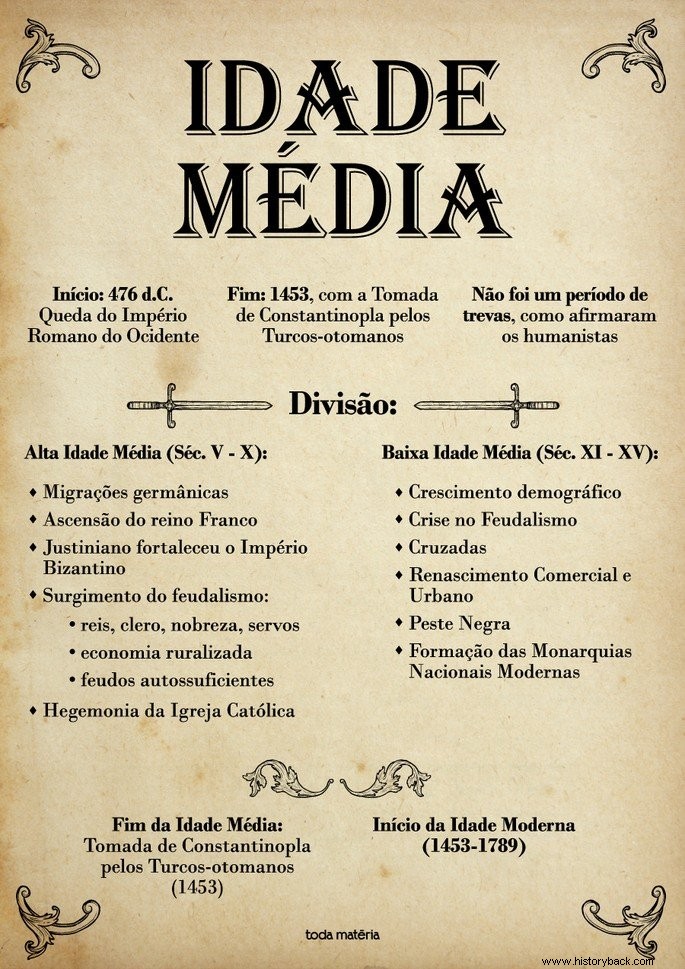The Middle Ages was a long period of history that stretched from the 5th century to the 15th century. Its beginning was marked by the fall of the Western Roman Empire, in 476 AD, and the end, by the Ottoman Turks' taking of Constantinople, in 1453.
It was also in this period that feudalism, a political, economic and social organization based on land tenure, emerged and was consolidated.
The humanists of the 15th and 16th century called the Middle Ages theDark Ages . They claimed to have taken place in Europe, an artistic, intellectual, philosophical and institutional setback in relation to the production of Classical Antiquity.
Characteristics of the Middle Ages
Historians divide the medieval period into two parts:the High Middle Ages and the Late Middle Ages . See below the main characteristics of each period.
High Middle Ages
The High Middle Ages was a period of instability and generalized insecurity, which lasted from the 5th to the 10th century.
- The Germanic Kingdoms – the Germans were peoples settled along the borders of the Roman Empire. The Romans called them "barbarians" because they were foreigners and did not speak Latin. The Germans formed several Germanic Kingdoms within Roman territory;
- The Christian Kingdom of the Franks – the kingdom of the Franks constituted the most powerful kingdom in Western Europe;
- The Church and the Holy Empire – The Medieval Church played an important role in society. It was at this time that it began to organize itself, with the aim of ensuring the homogeneity of the principles of the Christian religion and promoting the conversion of pagans.
- The Feudal System – Feudalism began to form in the 5th century, in Western Europe, with the crisis of the Roman Empire.
- The Byzantine Empire – established in Constantinople, the Byzantine Empire survived barbarian invasions and lasted throughout the medieval period.
- Arabs and Islam – in the Middle East, on the Arabian peninsula, Islam was born in 630, as a result of the Holy Wars waged by Muhammad. Slowly, Islam spread over an extensive territory, conquering lands in Asia, Africa and Europe.
Low Middle Ages
The Low Middle Ages is the period from the 11th to the 15th century. Highlights at this time:
- Crisis of Feudalism
- The Crusades and the Expansion of Christian Societies;
- Urban resurgence in Europe;
- The European commercial renaissance;
- The formation of European national monarchies;
- Medieval culture.
During the Late Middle Ages, with the expansion of the Ottoman Turks in the 14th century, taking the Balkans and Asia Minor, the Byzantine Empire was reduced to the city of Constantinople.
The fall in 1453 was a historical fact that marked theend of the Middle Ages in Europe . The conquest of the Byzantine capital by the Ottoman Empire under the command of Sultan Mohammed II, marked the end of the Roman Empire in the West.
Why did the Middle Ages get its name?
The thinkers of the modern period, called humanists, during the transition period between the Middle and Modern Ages, began a movement to return to Greco-Roman values and studies, having as a guide the valorization of the human being - anthropocentrism.
Thus, they came to understand the previous period as a moment of darkness, a medium where the rationality of Classical Antiquity was abandoned by the human being, until it was found again during the Modern Age.
Summary of the Middle Ages

